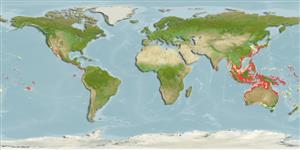Common names from other countries
Environment: milieu / climate zone / depth range / distribution range
Écologie
marin récifal; profondeur 5 - 50 m (Ref. 90102). Tropical
Indo-Pacific: Malaysia and Indonesia to Samoa, north to southern Japan, south to northwestern Australia and New South Wales.
Taille / Poids / Âge
Maturity: Lm ? range ? - ? cm
Max length : 38.0 cm TL mâle / non sexé; (Ref. 3132); poids max. publié: 580.00 g (Ref. 3132)
Épines dorsales (Total): 2; Rayons mous dorsaux (Total): 28-34; Rayons mous anaux: 27 - 34.
Inhabits estuaries and on coastal and offshore reefs (Ref. 9563); also on weed bottoms and on trawling grounds. Found on muddy or silty substrates (Ref. 48637). Is an omnivore which feeds mainly on seagrass, algae, gammarid amphipods and caridean shrimps as well as on bryozoans, hydroids, ascidians, copepods, caprellid amphipods and tanaidaceans (Ref. 13426).
Life cycle and mating behavior
Maturité | Reproduction | Frai | Œufs | Fécondité | Larves
Shen, S.C. (ed.), 1993. Fishes of Taiwan. Department of Zoology, National Taiwan University, Taipei. 960 p. (Ref. 5193)
Statut dans la liste rouge de l'IUCN (Ref. 130435)
CITES (Ref. 128078)
Not Evaluated
Menace pour l'homme
Harmless
Utilisations par l'homme
Pêcheries: intérêt commercial mineur
Plus d'informations
RéférencesAquacultureProfil d'aquacultureSouchesGénétiqueElectrophoresesHéritabilitéPathologiesTraitementMass conversion
Outils
Articles particuliers
Télécharger en XML
Sources Internet
Estimates based on models
Preferred temperature (Ref.
115969): 21.2 - 29, mean 28 (based on 898 cells).
Phylogenetic diversity index (Ref.
82804): PD
50 = 0.6250 [Uniqueness, from 0.5 = low to 2.0 = high].
Bayesian length-weight: a=0.02399 (0.01521 - 0.03784), b=2.82 (2.69 - 2.95), in cm Total Length, based on LWR estimates for this species & (Sub)family-body (Ref.
93245).
Niveau trophique (Ref.
69278): 2.4 ±0.1 se; based on diet studies.
Résilience (Ref.
120179): Milieu, temps minimum de doublement de population : 1,4 à 4,4 années (Preliminary K or Fecundity.).
Fishing Vulnerability (Ref.
59153): Low to moderate vulnerability (28 of 100).
